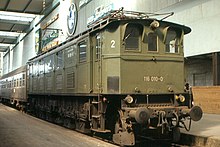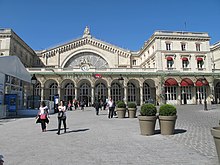Mozart (train)
The Mozart was an international long-distance train named after the composer Wolfgang Amadeus Mozart , which ran between Paris and Vienna from 1964 to 2002 . Previously, a forerunner train between Strasbourg and Salzburg had operated under this name since 1954 . In addition to the Orient Express , which ran at night , the “Mozart”, as a day train, was the most important rail link between Paris and Vienna for decades.
history
The Stuttgart "timetable pastor" Richard Ottmar developed the suggestion for a daily connection between Paris and Vienna after the Second World War . The Deutsche Bundesbahn quickly took up the proposal after the gradual elimination of the war damage made a daily connection possible with regard to the required travel times. It could not prevail against SNCF and ÖBB at first - a through car from Paris to Munich was also rejected.
The Deutsche Bundesbahn therefore introduced the "Mozart" as an F-train with only 2nd class cars between Strasbourg and Salzburg for the 1954 summer schedule . In Strasbourg, there was a connection with a Rapide to and from Paris, the SNCF had refused a through car transfer. The train left Strasbourg in the early afternoon and was in Salzburg in the evening. In the opposite direction, he ran from Salzburg in the late morning and was in Strasbourg in the early evening. The name "Mozart" had previously shortly after the war, only members of the US - occupying power worn reserved for express train between Vienna and Munich and Salzburg. In Vienna, the train had not served the Westbahnhof, but Vienna Franz-Josefs-Bahnhof , as this was in the American sector of Vienna.
The section between Munich and Salzburg was omitted for the winter timetable 1955/56. A year later, as part of the Europe-wide class reform on June 3, 1956, the train was classified as a pure 1st class train. In the same year it was again taken from Salzburg, initially only to the west, and in 1958 again shortened to Munich. In 1961 he received the through car to and from Paris, which the DB had long wanted. This was carried to Salzburg, nominally the "Mozart" continued to run only between Strasbourg and Munich. In 1962 a through car from Vienna to Strasbourg followed. This led to the unusual situation that although a day trip from Paris to Vienna was actually possible with a train, passengers who wanted to use the connection had to change cars between Strasbourg and Munich. In 1963 the "Mozart" was converted into an express train. In France it continued to be known as "Rapide" .
A year later, the train was converted from a through car connection into a through train Paris - Vienna. The travel time from Paris Gare de l'Est to Vienna Westbahnhof via Nancy , Strasbourg , Karlsruhe , Stuttgart , Munich , Salzburg and Linz , for example, in the 1971 summer timetable was 14 hours and 40 minutes, in the opposite direction the train took 13 minutes more. With the reintroduction of the FernExpress (FD) in 1983, the "Mozart" was classified as such. The type of train was somewhat unusual, otherwise the type “FD” comprised almost exclusively trains from the direction of northern Germany and the Ruhr area with destinations in holiday regions in southern Germany and Austria. At times the train carried through cars from Salzburg to Port Bou .
In 1987, the European railway authorities introduced the new Eurocity train type for high-quality international trains as the successor to the earlier Trans-Europ-Express trains . The "Mozart" was only classified as Eurocity in 1989. At the same time it was equipped with new, air-conditioned Eurofima coaches from ÖBB. In 1992 the travel time from Paris to Vienna was only 13 hours and 13 minutes, in the opposite direction it was three minutes less. From 1991, the train route had also received through cars from Paris to Graz and back.
When the timetable changed in December 2002, the “Mozart” was no longer a continuous connection between Vienna and Paris. The train name was initially retained with an EC pair between Munich and Vienna until it was replaced by a Railjet in 2009 . The EC trains between Paris and Munich were finally discontinued when the LGV Est européenne went into operation in 2007 and replaced by a pair of TGV trains.
Reuse of the train name
Since 2014 the Railjet 372/373 Graz - Vienna - Prague and back has been operated with a České dráhy train set under the name of Wolfgang Amadeus Mozart .
Vehicle use
In the first few years the "Mozart" was served exclusively with DB vehicles. The fleet consisted of blue F-Zug cars of the 2nd, from 1956 1st class, mostly of the pre-war types. The demand was comparatively weak, in some cases the train only consisted of a half dining car and a compartment car. In 1958 the train was converted into a two-class F train. Since then it has consisted of the usual DB express train cars. In later years he received wagons from the SNCF and ÖBB. The dining car has been provided by the CIWL since the extension to Paris and Vienna until the latter handed over their last own car in 1971. The catering for the wagons belonging to the state railways was handled by the CIWL for French and Austrian wagons, and by DSG for German wagons .
At the end of the 1970s, the "Mozart" got air-conditioned Eurofima coaches from ÖBB. It came next Corail wagons of the SNCF used the dining car was provided by the DB. With the conversion to EuroCity in 1988, the SNCF wagons were discontinued and 1st class was provided by DB. Since the 1991 summer timetable, the rolling stock has been completely converted to air-conditioned and pressure-proof Eurofima replicas from SGP of the ÖBB.

A large part of the route served was electrified when the train was introduced. Only between Strasbourg and Stuttgart were steam locomotives hauled by the "Mozart" in the first few years , usually the DR class 39 . The DB locomotives of the E 18 and E 17 series were deployed east of Stuttgart . The E 16 hauled the train between Munich and Salzburg . With the progressive expansion of the electrical network, the proportion of steam traction decreased, the locomotive change shifted from Stuttgart to Mühlacker and from 1958 the entire DB section was under contact wire. The pre-war locomotives were replaced by the new DB class E 10 at that time .
The German section of the train route, which was extended in 1964, was still handled by the E 10; the newer series 103 and 111 were not used until the 1970s . With the introduction of Zweisystemloks the DB class 181.2 took over this in 1975 the section between Stuttgart and Strasbourg, on the previously necessary change of locomotives in the border station Kehl could be dispensed with. Most recently, DB AG used the DB class 101 between Stuttgart and Munich until 2002 .
With the introduction of continuous locomotive runs between DB and ÖBB, ÖBB took over the locomotive hauling between Munich and Salzburg. For decades, it used the ÖBB 1042 , which was recently replaced by the ÖBB 1044 . Initially, the train was hauled by the ÖBB 4061 from 1964 .
The SNCF first used the SNCF BB 16500 on the Paris – Strasbourg line , which was already fully electrified in 1964 , and finally the SNCF BB 15000 hauled the "Mozart".
literature
- Fritz Stöckl : European railway trains with illustrious names . Carl Röhrig Verlag, Darmstadt 1958.
- Peter Goette: Light F-Trains of the Deutsche Bundesbahn . EK-Verlag, Freiburg, ISBN 978-3-88255-729-9 .
Individual evidence
- ^ Fritz Stöckl: European railway trains with sonorous names. Carl Röhrig Verlag, Darmstadt 1958, p. 194
- ^ Peter Goette: Light F-Trains of the Deutsche Bundesbahn . EK-Verlag, Freiburg, p. 125
- ^ Fritz Stöckl: European railway trains with sonorous names. Carl Röhrig Verlag, Darmstadt 1958, p. 175
- ^ Deutsche Bundesbahn (Ed.): Kursbuch Gesamtausgabe, Summer 1971 , Tables D2 and F3
- ↑ trains-en-voyage.com, Les EuroCity Paris-Munich , accessed on September 14, 2013
- ↑ Eurocity 2003 on fernbahn.de , accessed on September 14, 2013
- ^ Peter Goette: Light F-Trains of the Deutsche Bundesbahn . EK-Verlag, Freiburg, p. 126
- ^ Locomotive magazine: Austrians in Munich


